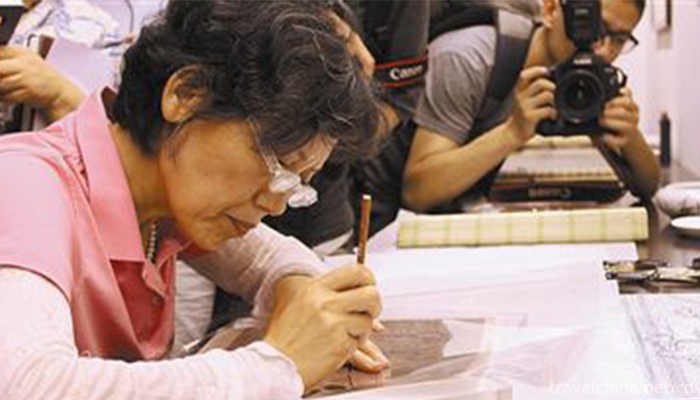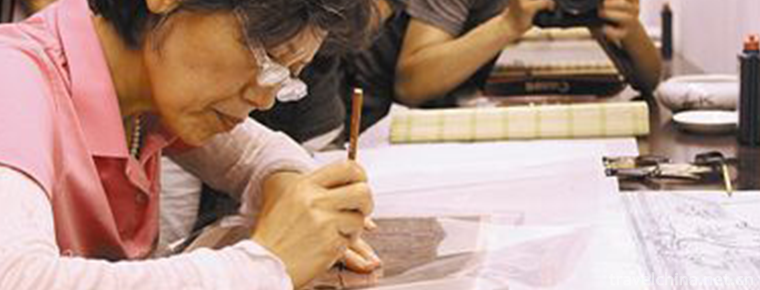Copying and Reproducing Skills of Ancient Calligraphy and Painting
Copying and Reproducing Skills of Ancient Calligraphy and Painting
Ancient painting and calligraphy copying technology, the traditional copying technology of Beijing Palace Museum, one of the national intangible cultural heritage.
Copying of ancient calligraphy and painting is a complicated process, which mainly includes sketching, ink dropping, coloring, obsolescence, title and seal copying.
On May 23, 2011, the copying and reproduction skills of ancient calligraphy and painting were approved by the State Council of the People's Republic of China and listed in the third batch of national intangible cultural heritage list, item number_-202.
historical origin
Ancient Chinese paintings and calligraphy, mostly silk or paper, are limited by preservation conditions. Many authors'handwriting has not been preserved. Many of them are copies of contemporary or future generations. Like Gu Kaizhi's Picture Volume of Women's History (now in London British Museum), most experts believe that it is a copy of the late Sui and early Tang Dynasty; his Picture of Luoshen Fu is actually a copy of the Song Dynasty. Wang Xizhi's Lanting Preface, known as "the first line book in the world", has been handed down from generation to generation as a copy of Tang Feng Chengsu (now Tibetan Palace Museum in Beijing), Zhu Suiliang's Linben and Yu Shinan's Linben. Tang Zhangxuan's Tampering Picture Volume (now in Boston Museum of Art) is a copy of Zhao Yu of the Northern Song Dynasty. Many successful painters in history are masters of ancient imitation, such as Zhao Mengfu, Dong Qichang, Jincheng and Zhang Daqian. The copying of ancient paintings in New China began with Rongbao Zhai in Beijing. In the early 1950s, Rong Baozhai creatively developed the watermarking reproduction technology of woodblock prints of calligraphy and painting, and achieved the effect of chaos and authenticity. Copying precious original copies became an indispensable important process of woodblock watermarking reproduction of ancient calligraphy and painting.
Process characteristics
Copying is the traditional technique of ancient calligraphy and painting reproduction.
Ling is looking at the original painting, copying is the following manuscript, to draw exactly according to the manuscript, copying is the combination of the two. The requirements of the work are extremely sophisticated and complex, and must be meticulous. The physical strength and eyesight of the copyist are severe tests.
Because copying is handmade, the efficiency is very low and the quantity is very small. The copyists of famous calligraphy paintings should have high artistic attainments. Only by virtue of their profound skills in the creation and appreciation of calligraphy and painting and their profound personal artistic accomplishment, and on the basis of a full understanding of the original works, can they copy the original works in order to ensure the artistic value of the copyed works.
Because both paper and silk have a life span, they will melt away in hundreds of years, even after better repairs. Moreover, ancient paintings and calligraphy are very demanding on the environment, sensitive to temperature, humidity and lighting. First-class cultural relics are not allowed to be displayed for more than 10 days, and they have to rest for several years once. "In order to satisfy the exhibition effect of the museum, the best way is to use imitation, which is the only way to keep the cultural relics alive."
Technological process
The copying techniques of ancient calligraphy and painting in the Palace Museum mainly include sketching, ink dropping, coloring, old making, title and seal copying.
(1) Draft sketch, also known as glue plate, first cover the surface of the duplicate or enlarged photo of the painting with film or transparent glue plate, and then remove the original line.
(2) Ink dropping, that is, to lay a good silk on the plastic film with lines, refer to the original pen and ink weight, and drop the drawing on the silk cloth. It can be coloured after falling ink.
(3) Coloring, which can be divided into back and front coloring.
(4) To do the old, the process of coloring needs to do the old treatment, the old and coloring can be synchronized or crossed. In the process of copying, the texture of "old" is achieved mainly through techniques and colours, instead of using chemicals to make new paintings old, which requires a high level of skill and experience of copying.
(5) The inscription is also called the inscription and postscript of the famous inscription, in which two methods, i.e. drawing and outlining, and copying, are used. Drawing (i.e. photocopying) and outline filling (i.e. using double ticks before filling in), both of them use the pen method to describe (i.e. using several pens to describe a pen); copying the old, you can temporarily paste a piece of ripe paper with the same shape as the broken part in the broken pen, and then remove the blanks, just like gradual pen but can maintain the momentum of a pen, the broken part also. It can be set aside when writing and used in conjunction with handwriting. After copying, the color uniformity is newer and gluey, which can be absorbed downward with raw rice paper for supernatant water. After several times, the gluey property will be removed, and the part will be repaired with the same head.
(6) Seals, first of all, a comprehensive analysis of all the seals on the whole picture, and then a copy, and then, according to the original seal, the seal engraver family knife and pen to copy copperplate seals to repair. In the process of plate making, the seal may be some distance from the original outline, the distortion needs to be corrected, the rough text needs to be trimmed, and the interesting and woolen stones need to be trimmed out until the test cover is satisfactory. The imitation of the seal has been completed.
Inheritance and protection
Inheritance value
Traditional Chinese ancient painting and calligraphy artificial copying technology is an important traditional handicraft in China, with a long history and clear heritage. Copying rare books of ancient painting and calligraphy has long been an important means of inheriting the art and techniques of ancient Chinese painting and calligraphy.
Inheritance status
At present, the professional technicians engaged in copying ancient calligraphy and painting in the Palace Museum are older, and there are some difficulties in inheritance.
Inheriting characters
Zu Ze, female, was born in March 1956. In December 2012, Zu Ze was selected as the representative successor of the fourth batch of national intangible cultural heritage projects. The Palace Museum declared and declared the project: ancient calligraphy and painting copying skills.
Guo Wenlin, male, Manchu, in May 2018, Guo Wenlin was selected as the representative successor of the fifth batch of national intangible cultural heritage projects. The Palace Museum declared and declared the project: copying skills of ancient calligraphy and painting.
protective measures
After the founding of New China, the Palace Museum set up a cultural relics restoration factory, hired Jin Zhongyu, Zheng Zhuyou, Feng Zhonglian, Jin Yumin, Chen Linzhai and other masters to enter the Palace Museum, copying the national treasure-grade calligraphy and painting cultural relics collected by the Palace Museum, which has a positive role in promoting the development of cultural relics protection and the inheritance of traditional skills.
Guo Wenlin is the successor and subject leader of Chinese ancient painting and calligraphy copying technology. He not only teaches and directs individual skills, but also teaches the course of ancient painting and calligraphy copying at the College of Culture and Museum of Beijing Normal University. At the same time, he actively engages in various training courses of ancient painting and calligraphy copying, and cultivates talents of ancient painting and calligraphy copying for other museums.
social influence
Important exhibition
From June to November 2012, the National Exhibition of Copying and Reproducing Skills and Mounting and Restoring Skills of Ancient Calligraphy and Painting, a national intangible cultural heritage, was exhibited at the Palace Museum in Beijing, in which the copying and reproducing skills of ancient calligraphy and painting were exhibited.
Representative works
Gu Kaizhi's Pictures of Women's History in the Late Sui and Early Tang Dynasties
Gu Kaizhi's Luo Shen Fu Tu


-
1.Luofu Mountain Scenic Area
Luofu Mountain Scenic Area is a national AAAAA level scenic area. It is located on the Dongjiang River of Guangdong Province, 35 kilometers away from Boluo County, Huizhou City
Time 2018-12-12 -
2.Jiankou Great Wall
The Great Wall is located in Badaohe Township, northwest of Huairou District, Beijing suburb. It is 1141 meters above sea level and about 30 kilometers away from Huairou County.
Time 2019-01-21 -
3.Maoling Museum
Maoling Museum is located on the Wuling Platform between Xianyang and Xingping in Shaanxi Province, about 40 kilometers away from Xi'an. It is a Museum of Dynastic History of the Western Han Dynasty
Time 2019-02-07 -
4.Zhenjiang Jinshan Temple
Jinshan Temple was built in Jinshan Mountain on the South Bank of the Yangtze River in Zhenjiang City, Jiangsu Province, at the time of Emperor Ming of the Eastern Jin Dynasty
Time 2019-03-18 -
5.Stone carving
Stone carving is a traditional Chinese folk micro-sculpture process. The peach stone, apricot stone, olive stone and walnut are carved into handicraft products, which have been listed in the second ba
Time 2019-05-03 -
6.Hui folk instrumental music
Hui folk instrumental music is a long-term life practice and cultural activities of the Hui people in Ningxia, inheriting ancient instruments of Ningxia and northwest frontier fortress instruments and
Time 2019-05-04 -
7.Wenzhou Drum Ci
Wenzhou Drum Ci, also known as "Quci" or "Blind Ci", commonly known as "Singing Ci", is the largest type of opera in southern Zhejiang Province, and also one of the main
Time 2019-06-28 -
8.Wuqiang Wood Engraving New Year Picture
Wuqiang New Year's Painting is one of the traditional folk crafts in Wuqiang County, Hebei Province. It is named for its origin in Wuqiang County, Hebei Province. It is a unique style of Chinese folk
Time 2019-06-30 -
9.Xilu Bangkok
Xilu Bangzi a Xilu Bangzi is an ancient traditional opera. Now the embryonic form of Hebei Bangzi was formed in Qingdaoguang period. Its predecessor is Shanshan-Shaanxi Bangzi, which was introduced in
Time 2019-07-01 -
10.Gu Kaizhi
Gu Kai Zhi (348 to 409 years), the word is long, the small character tiger. Han nationality , Jin Ling Wuxi people (now Wuxi, Jiangsu province). Outstanding painter, painting theorist and poet. Becaus
Time 2019-09-07 -
11.Suzhou University
Suzhou University is a full-time undergraduate college in Anhui province. It is an applied undergraduate university in Anhui province. Anhui higher education revitalization program "Local applica
Time 2019-11-21 -
12.Dragon elbow mountain
Longcub mountain, also known as yuxu mountain, is located in Longquan Township, northwest of Huili County, Liangshan Yi Autonomous Prefecture, Sichuan Province, China. It is also known as yuxu mountain at the junction of Baiguowan
Time 2020-10-16